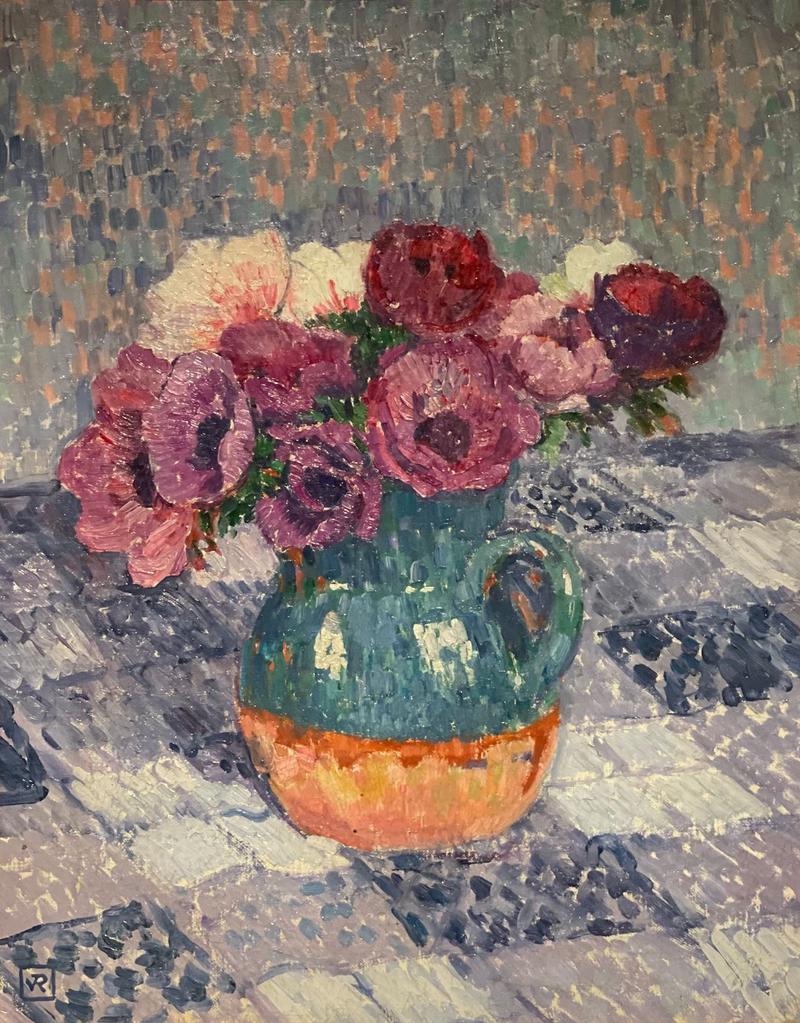Vase de Fleurs

Theo van Rysselberghe (1862-1926) was one of the most important figures in the field of Neo-Impressionism. He introduced the pointillist technique into Belgium and played a major role in the artistic circle of the Brussels avant-garde which in the late nineteenth century was a leading centre of new and exciting international art.
The artist made his first steps towards Impressionism from 1880 and in 1883 became one of the six founders of Les XX, a Belgian artistic circle of young radical artists who, like the French Impressionists, rebelled against outmoded academia. Having come into contact with the work of Monet and Renoir, van Rysselberghe’s palette lightened from a darker northern palette and he, like them, became obsessed with the portrayal of light. At this time, he first discovered the work of Seurat and was so moved by the experience that he broke his cane in half. It led to his abandonment of realism in favour of a pointillist technique, becoming known not just for neo-impressionist landscapes but portraiture also.
Throughout his life, Van Rysselberghe’s rebellious temperament was attracted to new and anarchic ideas and he recognised and championed radical ideas of young artists, helping to construct a “conscious and organized insurrection against academicism.” He completely embraced pointillism even after Seurat’s La Grande Jatte was criticised in the Belgium press as “incomprehensible gibberish applied to the noble art of painting.” He invited Vincent Vin Gogh to exhibit in Belgium and it was here that Vincent sold the only painting he ever sold during his lifetime. The only mistake that Van Rysselberghe ever made in terms of recognising talent was his rejection of Picasso whose Blue Period he termed “ugly and uninteresting”.
Van Rysselberghe painted alongside Camille Pissarro in Bruges and Knokke. Pissarro at the time was moving away from the neo-impressionist divisionist technique that he had adopted and which he was beginning to feel was too cold and clinical. Van Rysselberghe later did the same, returning to the use of a broader brushstroke of integrated colour which he employs in Vase de Fleurs whilst still segmenting the colour. By this time, at the turn of the century, he was producing vibrant canvases using a vivid palette of luminous colours with intense contrasts and softened shaded hues. The artist often enjoyed ‘electric’ colour combinations but here he employs a harmonious and tranquil colour scheme.
Van Rysselberghe was a born traveller and all his life he felt the pull of distant lands. He travelled extensively to Morocco, Athens, Constantinople, Hungary, Romania, Moscow and Saint Petersburg. In 1898 he moved to Paris and in 1911 settled on the Côte d’Azur. Here he built a house with his brother Octave and fellow painter and anarchist Henri-Edmond Cross. Following his death in 1926, Fénéon wrote that his friend’s greatest wish had been to live in a caravan, put on travelling exhibitions and once successful, to burn all his paintings, to avoid speculation by art collectors. Ironically, most of his works are now in private collectors’ hands and are only rarely seen.



